Biology
Biology concepts ? meristem, monocot, dicot, herbaceous, arborescent, xylem, phloem
Summer brings warmer weather, outdoor activities, and yard work. Tree trimming is rare, but mowing the lawn is a weekly chore. I like mowing in April, May, and June, but by August and September, I?m over it.
A meristem (meristos= divisible, and em = the ending from xylem and phloem) is vascular tissue that can divide; they are the source of all new cells in growing plants. Meristem cells act much like stem cells; they each have the potential to become many different types of cells. However, I could not find evidence that the older word, meristem, was the source of the term stem cell.
Grasses may also have nodal meristems; these allow for growth between the nodes, as well the addition of leaves and such. Bamboo is a grass in which you can see the nodes very well (see picture), and growth from each node is one of the reasons why bamboo can grow so quickly. While bamboo may feel like wood, it is a monocot like other grasses, and therefore is not what we consider true wood.
A new study has investigated how fruits can also induce dormancy in meristems. So much energy is put into fruit development that energy must be stolen from plant growth. The fruits themselves produce auxin to save energy by stopping meristem function. This is why fruit trees have alternating years of fruit vs. growth; when they make fruit they don?t grow, and when they grow, they don?t make much fruit.
So now we know why you have to mow your grass ? you don?t cut the low-placed monocot meristems when you mow, but dichotomous trees that are trimmed back lose their shoot apical meristems, therefore they don?t re-grow limbs. But, as always there are exceptions.
In some cases, a new trunk may sprout from a dormant meristem in a cut stump. This is called ?stump sprouting? or epicormic growth (epi= on top of, and cormal= trunk stripped of its boughs). In botanical terms, epicormic has come to mean growth from a previously buried, dormant meristem. This type of growth occurs most in hardwoods and has become important for regeneration of wood in the forestry industry, but it has also been used to help propagate Christmas trees (which are softwood conifers).
Next week, one final summer post question before we start investigating exceptions to rules again. We know that prokaryotes come in various shapes, but why - what has shape got to do with survival. And just what shapes are possible anyway - would you like to see star-shaped bacteria?
Smith HM, & Samach A (2013). Constraints to obtaining consistent annual yields in perennial tree crops. I: Heavy fruit load dominates over vegetative growth. Plant science : an international journal of experimental plant biology, 207, 158-67 PMID: 23602111
Leida C, Conejero A, Arbona V, Gómez-Cadenas A, Llácer G, Badenes ML, & Ríos G (2012). Chilling-dependent release of seed and bud dormancy in peach associates to common changes in gene expression. PloS one, 7 (5) PMID: 22590512
Müller D, & Leyser O (2011). Auxin, cytokinin and the control of shoot branching. Annals of botany, 107 (7), 1203-12 PMID: 21504914
- Plant Divisions
4 Plant Divisions: Bryophytes are the most common plant division and are made up mosses, liverworts and hornworts. They are found in almost every habitat, including deserts but are most adaptable to moist environments. This is thought to be the first...
- Phloem & Xylem
Are Phloem and Xylem Similar? What are the Differences? Similarities: Phloem and xylem are tissues in a plant that transport food and water. Both are vascular tissues and when they work together to effectively transport food, water and minerals they form...
- #41 Transport In Phloem
The movement of substances in phloem tissue is called translocation. The main substances that are moved are sucrose and amino acids, which are in solution in water. These substances have been made by the plant and are called assimilates. Phloem...
- #39 Structure Of Transport Tissues In Plants
Plants have 2 transport systems: xylem: transports water and inorganic ions from the roots to the leaves.phloem: transports food made in the plant (sucrose and amino acids) from the leaves to the rest of the plant. Both of...
- The Life Of The Party
Biology concepts ? plant adaptations, osmosis, parthenogenesis Last week we discussed the biological implications of an old Christmas carol. Today?s post is a hodgepodge of holiday biology, but we can still find some exceptions. From a distance, spruce,...
Biology
Go Prune the Grass?
Biology concepts ? meristem, monocot, dicot, herbaceous, arborescent, xylem, phloem
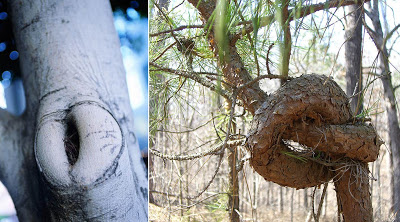 |
Knots can form in trees for different reasons. When you prune a limb back and a callus grows over it in a few years, this may form a loose knot. Even limbs that are still there begin to be swallowed by the expanding trunk; this would be a tight knot. The knot on the right is not usual. |
Question of the day ? Why does the cut grass grow back, but when you prune a tree limb, it stops growing from that end?
You cut the ends of the blades of grass and they grow back in a week or so. But have you ever seen a limb regenerate on a tree? It would be unusual; if you cut the limb off, the tree forms a knot as the trunk grows around the cut stub.
The difference lies in the kinds of plants grass and trees are, and how these types of plants grow. Most trees are dicotyledon (di = two, and cotyledon = embryonic leaf) plants, while most grasses are monocotyledons(mono = one). The differences between these types of plants are many, but the names come from the various embryonic forms they take in their seed.
Monocots generally do not overwinter well, are herbaceous (without woody stems), have fibrous root systems, and have flowers with petals in multiples of three. The leaves of monocots usually have veins that are parallel to the direction of growth, and the leaves are most often long and thin. They way they move water and nutrients (in the xylem and phloem, respectively), is constructed in small islands, with many bundles of xylem and phloem spread throughout the stem.
Dicot plants, on the other hand, are often perennial plants that survive winters well. They can herbaceous or arborescent (woody), and their transport systems (phloem and xylem) are arranged in concentric circles. Long, deep taproots are more common in dicots, as are flowers with petals in groups of four or five and broad leaves with networked veins.
Monocots and dicots have similar structures (leaves, flowers, stems, etc.) but they arrange them differently and they have different properties. One thing they have in common is that their parts are generated from similar cells, in structures called meristems.
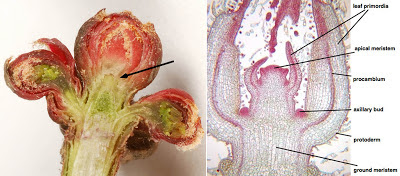 |
On the left is a cutaway of a bud. The arrow points to the meristem tissue from which all other cells develop. On the right is a photomicrograph of the meristem, showing the different structures that form from it. The meristem sits on top of, and is surrounded by, the structures it formed previously (larger leaf primordial and axillary buds). The procambium will become the xylem and phloem. |
A meristem (meristos= divisible, and em = the ending from xylem and phloem) is vascular tissue that can divide; they are the source of all new cells in growing plants. Meristem cells act much like stem cells; they each have the potential to become many different types of cells. However, I could not find evidence that the older word, meristem, was the source of the term stem cell.
All plants have meristems, both monocots and dicots - no exceptions, if you can believe it. The smallest flowering plant, Wolffia globosa, has meristems, though the whole plant is only a millimeter long. Some meristem features are found only in dicots and others only in monocots, one type of meristem that both plant types share is the apical meristem.
Shoot apical meristems make new stems, shoots, leaves and other above ground structures. The pluripotent cells of the meristem divide and differentiate to become the cells that are needed. The structure of the typical meristem is shown in the picture to the above.
In grasses, there are shoot apical meristems, although they may sometimes be called intercalary meristems. They are located at the base of the leaves and the stem, and allow for re-growth of the leaf after it is grazed by herbivores?. or mowed down by Harry Homeowner. Therefore, blame the evolution of low placed meristems as an adaptation to deal with prehistoric cows and goats for your need to mow each week.
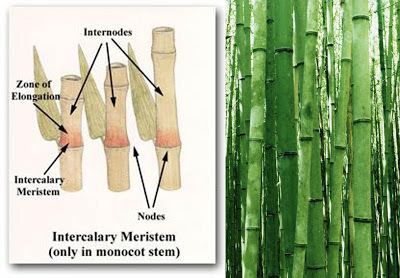 |
Node meristems are forms of intercalary meristems. Growth can continue to take place from each node. On the left is bamboo, a good example of a monocot grass with nodal meristems. |
On the other hand, most trees are dicots. Their shoot apical meristems are located at the ends of their limbs and top of the trunk. As the tree grows, limbs branch off from the trunk, each forming from a different shoot apical meristem.
The apical meristems at the ends of the limbs and top of the trunk take the shape of buds in the spring. Each bud will become a short twig and leaf. In the fall, the leaf falls off, the tree goes dormant, and the next spring a new bud forms on the end and the process is repeated.
This is how a branch becomes longer. If you prune back a limb, rarely will it grow from the pruned end ? you cut the meristem cells away! The limb may grow from one of the branch points behind where you pruned, but not from the cut end.
Trunks get taller and limbs get longer from these apical meristems, but there are also axillary (lateral) meristems produced when a limb branches or a leaf grows from the twig. However, most of these meristems do not support growth; they remain dormant.
The meristem at the top of the trunk and the end of the limb are dominant; they produce plant hormones to prevent growth from the meristems below them (on the trunk) or closer to the trunk (on limbs). This is why many trees have a single, central trunk. If that meristem is lost, one or more may become dominant and several trunks may form.
Auxin is the hormone that induces and maintains dormancy in lateral meristems, while cytokinin hormones promote growth from the laterals. For a good review of their roles, see the paper of Muller and Leyser from 2011. Other plant hormones are relevant for induction and emergence from dormancy induced by winter for all meristems. Abscisic acid (ABA) induces winter dormancy while gibberellins break the dormancy. A 2012 study has defined gene expression patterns during short and long-term cold spells and how they affect the ABA/gibberellin ratio and how short cold periods alter ABA concentrations.
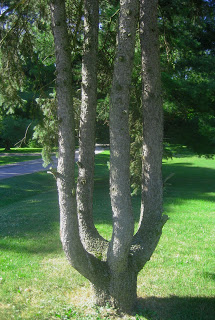 |
When a dominant apical meristem is lost, a dormant axillary (lateral) meristem may take over to become the new trunk. However, sometimes more than one may try for dominance, as in this conifer located near my home. |
A new study has investigated how fruits can also induce dormancy in meristems. So much energy is put into fruit development that energy must be stolen from plant growth. The fruits themselves produce auxin to save energy by stopping meristem function. This is why fruit trees have alternating years of fruit vs. growth; when they make fruit they don?t grow, and when they grow, they don?t make much fruit.
In some cases, if the shoot apical meristem is lost, the lateral meristem on a branch can become the dominant shoot apical meristem and the branch will begin vertical growth as a new trunk. However, this isn?t always the case (see picture to the right).
These are the ways trees get taller and fuller, but it's also related to how they get thicker. Apical meristems give rise to a thin line of cells that form the procambiumand the secondary meristem all around the periphery of the trunk or limb.
Just as apical meristems form buds and leaves when the winter breaks, so do secondary meristems form new vascular tissue all around the periphery each growing season, this tissue is called the vascular cambium. We see their work as the rings that can be used to age a tree (dendrochronology). Twigs don?t stay twigs because each year their secondary meristems make them thicker.
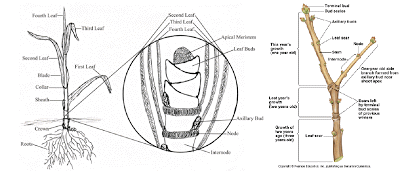 |
A cartoon of grass is on the left, showing that the meristem is located low on the plant. On the right is a twig of a dicot tree growing from the end, several buds may form during one growing season, but if you cut them off, growth stops. |
Exception one - some things we call trees are actually monocots, not dicots. If you look at the wood from a palm tree or a cordyline, you can see the small, dispersed groupings of vascular tissue that are typical of monocots. The reason they grow taller and appear more like trees is that they produce more lignan than other monocots, so they can grow taller. Lignan is the stiffest of the plant structural tissues and provides the resistance to gravity and wind.
Palm trees also have secondary mersitems, similar to the vascular cambium in dicot trees that add girth. However, palm secondary meristems just add more vascular bundles, not the rings of vascular tissue you see in dicot trees.
The second exception has to do with regrowth of trees even when the complete limb or trunk is cut away. There are meristems that get buried by the expanding wood layers of the trunk or when a limb grows thicker.
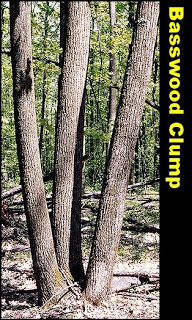 |
Basswood is one example of a tree that grows much better from stump sprouts than from seeds. Almost all basswood is harvested from clumps of trees that have sprung up from a previous stump. Basswood rarely grows a full tree from a seed, which makes me wonder why they still make seeds. |
Regeneration of whole trees by stump sprouting is based on loss of inhibitory chemical signals and stimulation of stem cells, much like last week?s discussion of the stem cells in your nail matrix and how they can regenerate the tips of your fingers. Maybe soon we will catch up to plants and be able to grow new limbs.
Smith HM, & Samach A (2013). Constraints to obtaining consistent annual yields in perennial tree crops. I: Heavy fruit load dominates over vegetative growth. Plant science : an international journal of experimental plant biology, 207, 158-67 PMID: 23602111
Leida C, Conejero A, Arbona V, Gómez-Cadenas A, Llácer G, Badenes ML, & Ríos G (2012). Chilling-dependent release of seed and bud dormancy in peach associates to common changes in gene expression. PloS one, 7 (5) PMID: 22590512
Müller D, & Leyser O (2011). Auxin, cytokinin and the control of shoot branching. Annals of botany, 107 (7), 1203-12 PMID: 21504914
- Plant Divisions
4 Plant Divisions: Bryophytes are the most common plant division and are made up mosses, liverworts and hornworts. They are found in almost every habitat, including deserts but are most adaptable to moist environments. This is thought to be the first...
- Phloem & Xylem
Are Phloem and Xylem Similar? What are the Differences? Similarities: Phloem and xylem are tissues in a plant that transport food and water. Both are vascular tissues and when they work together to effectively transport food, water and minerals they form...
- #41 Transport In Phloem
The movement of substances in phloem tissue is called translocation. The main substances that are moved are sucrose and amino acids, which are in solution in water. These substances have been made by the plant and are called assimilates. Phloem...
- #39 Structure Of Transport Tissues In Plants
Plants have 2 transport systems: xylem: transports water and inorganic ions from the roots to the leaves.phloem: transports food made in the plant (sucrose and amino acids) from the leaves to the rest of the plant. Both of...
- The Life Of The Party
Biology concepts ? plant adaptations, osmosis, parthenogenesis Last week we discussed the biological implications of an old Christmas carol. Today?s post is a hodgepodge of holiday biology, but we can still find some exceptions. From a distance, spruce,...
